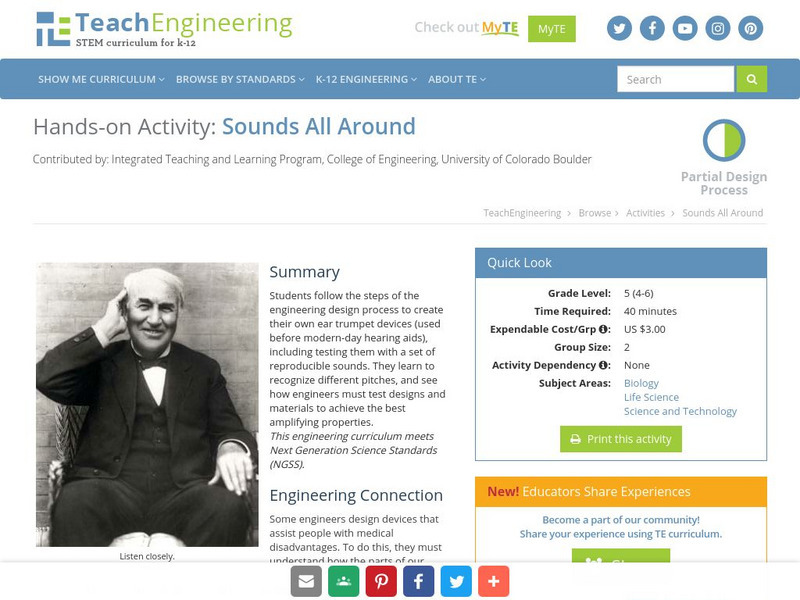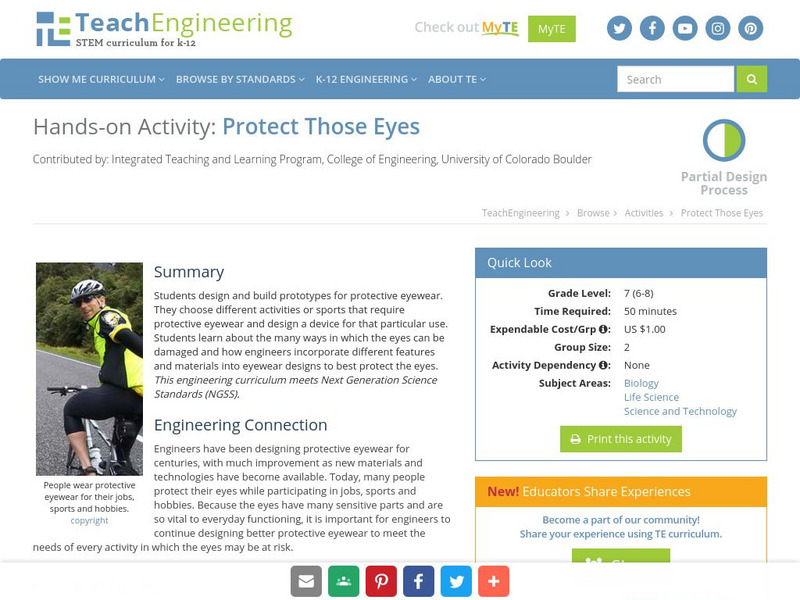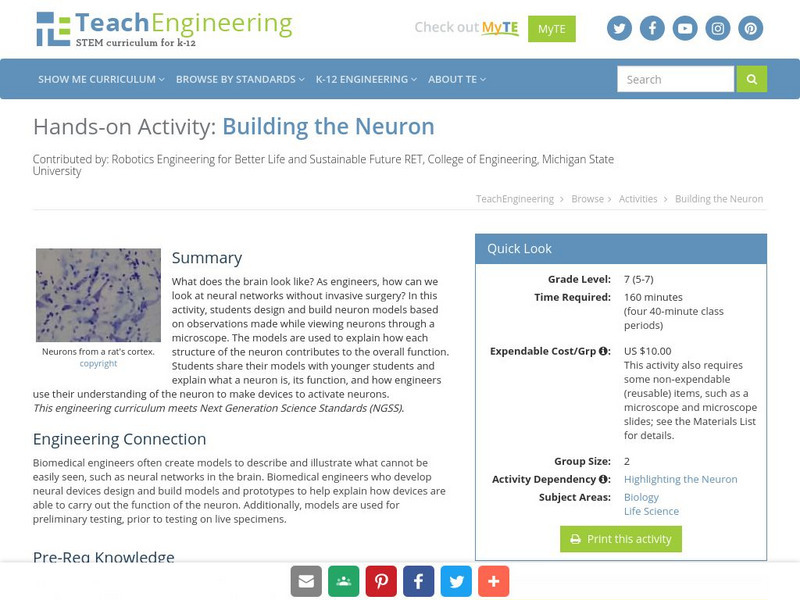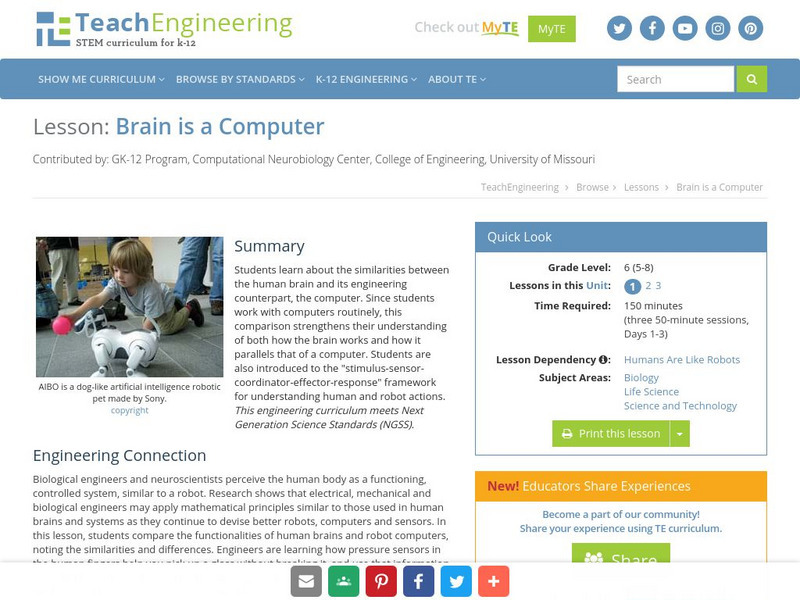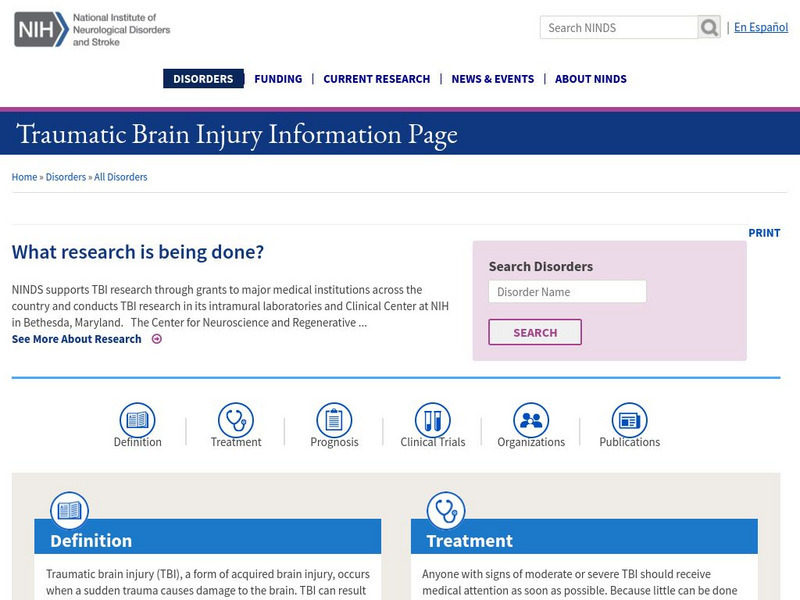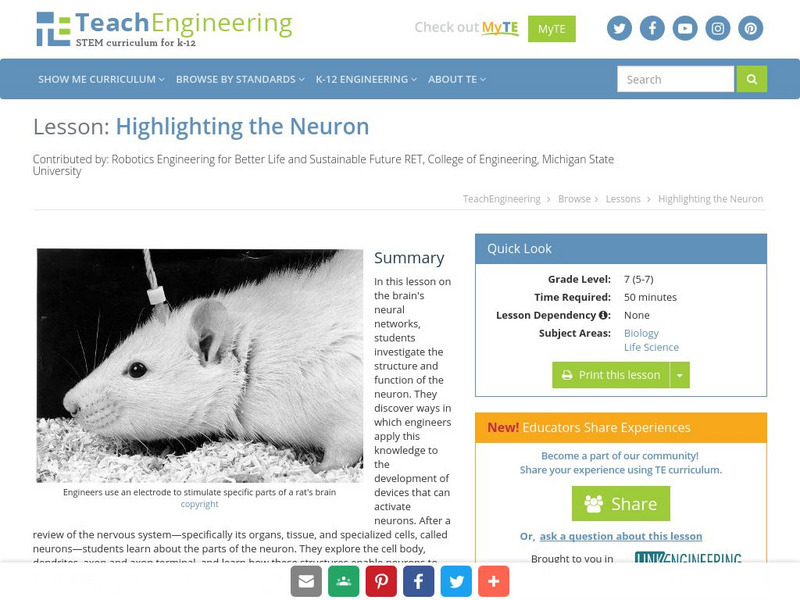TeachEngineering
Teach Engineering: Sounds All Around
Students follow the steps of the engineering design process to create their own ear trumpet devices (used before modern-day hearing aids), including testing them with a set of reproducible sounds. They learn to recognize different...
TeachEngineering
Teach Engineering: Protect Those Eyes
Students design and build prototypes for protective eyewear. They choose different activities or sports that require protective eyewear and design a device for that particular use. Students learn about the many ways in which the eyes can...
TeachEngineering
Teach Engineering: A Tasty Experiment
Students conduct an experiment to determine whether or not the sense of smell is important to being able to recognize foods by taste. They do this by attempting to identify several different foods that have similar textures. For some of...
TeachEngineering
Teach Engineering: Building the Neuron
In this activity, students design and build neuron models based on observations made while viewing neurons through a microscope.
TeachEngineering
Teach Engineering: How Do Sensors Work?
Through six lesson/activity sets, students learn about the functioning of sensors, both human and robotic
TeachEngineering
Teach Engineering: Brain Is a Computer
Students learn about the similarities between the human brain and its engineering counterpart, the computer. Since students work with computers routinely, this comparison strengthens their understanding of both how the brain works and...
NASA
Nasa: The Brain in Space
This educators guide shows young scholars how the body's brain, spinal cord and network of nerves control the activities of animals and humans.
National Institutes of Health
Ninds: Coma and Persistent Vegetative State Info Page
Loads of answers to just about any question you may have about comas. This site discusses what coma is, whether there is treatment, what the prognosis might be like, research on comas, and more.
National Institutes of Health
Ninds: Traumatic Brain Injury Information Page
Description of traumatic brain injury, which can lead to a coma. Discusses what TBI is, how it is treated, what the prognosis might look like, and research that is being done in the movie.
Other
Get Body Smart: Human Anatomy and Physiology: System Quizzes
A collection of interactive, self-checking quizzes on human body systems. Covers muscular, skeletal, circulatory, nervous, and respiratory systems.
Annenberg Foundation
Annenberg Learner: The Human Brain
Explore the human brain, and the role it plays in the nervous system. Students learn about the three main parts of the brain and each of their functions.
BBC
Bbc: Scotland: Brainsmart
Beginners guide to how the human brain works and suggestions for taking care of it, memorizing numbers, remembering names, managing stress, and more. Take a trip inside and see what happens when it learns something new.
TeachEngineering
Teach Engineering: Highlighting the Neuron
In this activity on the brain's neural networks, students investigate the structure and function of the neuron. They discover ways in which engineers apply this knowledge to the development of devices that can activate neurons. Includes...
OpenStax
Open Stax: Anatomy and Physiology: Nervous Tissue
Learn here about nervous tissue, tissue that is composed of two types of cells - neurons and glial cells.
OpenStax
Open Stax: Anatomy and Physiology: The Function of Nervous Tissue
Learn here about how nervous tissue is capable of communicating within the nervous system.
Other
Health Talk Online: Chronic Pain
This comprehensive resource contains individual video interviews with medical professionals and a number of people who have experienced chronic pain. What is chronic pain? What different approaches are used to manage pain? What type of...
Akron Children's Hospital
Akron Children's Hospital: Kids Health: El Cerebro Y El Sistema Nervioso
Learn about the different parts of the brain. The page is also available in English.
PBS
Pbs Learning Media: Body Control Center
Throughout the day, your nervous system monitors and makes endless adjustments to your body's basic systems--all to keep you alive. This interactive feature illustrates the complexity of such a task.
Howard Hughes Medical Institute
Hhmi: Biointeractive: The Virtual Neurophysiology Lab
Investigate the nervous system by looking at nerve cells in this virtual lab. This lab exercise allows students to experience a virtual dissection of a leech to use electronic equipment to explore the electrical activity of nerve cells....
National Cancer Institute at the National Institutes of Health
Seer Training Modules: Introduction to the Nervous System
Self-guided learning activity where students learn about the structure and function of the human nervous system. There is a short quiz at the end of the lesson to check for understanding.
Indiana University
Indiana University: Sensory Integration: Tips to Consider
This article gives examples of how it looks when a child is experiencing sensory processing issues and gives tips on how to provide a sensory diet to "nourish" a child's nervous system. The examples and tips are categorized into groups...
Biology 4 kids
Biology4 Kids: Quiz: Nervous System
Take this ten-question review quiz over the nervous systems of animals. Read more about each question after an incorrect answer is given.
McGraw Hill
Glencoe: Biology: The Animal Body and Principles of Regulation Pretest
Students have the opportunity to take this five question pretest to assess their knowledge of the principles of regulation in the human body.
McGraw Hill
Glencoe: Biology:the Nervous System Pretest
This quick five question pretest will allow students to assess their knowledge of the human central nervous system.


